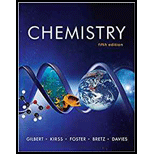
Concept explainers
Interpretation: The concentration of copper ion complex on dissolving the given concentration of
Concept introduction: The complex ion formation constant is given by the formula,
To determine: The concentration of copper ion complex in the aqueous solution of ethylenediamine.
Answer to Problem 16.70QP
Solution:
The concentration of copper ion complex in the aqueous solution of ethylenediamine is
Explanation of Solution
Given
The molar concentration of
The molar concentration of ethylenediamine is
The total volume of the solution is
Copper nitrate on dissolving in the aqueous solution of ethylenediamine forma a complex ion with ethylenediamine as,
The complex ion formation constant,
The concentration of formation of
The ICE table for the formation of
The complex ion formation constant is given by the formula,
Substitute the value of
The value of
Therefore, the above equation becomes,
The concentration of
Therefore, the concentration of
Conclusion:
The concentration of in
Want to see more full solutions like this?
Chapter 16 Solutions
CHEMISTRY:SCI.IN CONTEXT (CL)-PACKAGE
 ChemistryChemistryISBN:9781305957404Author:Steven S. Zumdahl, Susan A. Zumdahl, Donald J. DeCostePublisher:Cengage Learning
ChemistryChemistryISBN:9781305957404Author:Steven S. Zumdahl, Susan A. Zumdahl, Donald J. DeCostePublisher:Cengage Learning ChemistryChemistryISBN:9781259911156Author:Raymond Chang Dr., Jason Overby ProfessorPublisher:McGraw-Hill Education
ChemistryChemistryISBN:9781259911156Author:Raymond Chang Dr., Jason Overby ProfessorPublisher:McGraw-Hill Education Principles of Instrumental AnalysisChemistryISBN:9781305577213Author:Douglas A. Skoog, F. James Holler, Stanley R. CrouchPublisher:Cengage Learning
Principles of Instrumental AnalysisChemistryISBN:9781305577213Author:Douglas A. Skoog, F. James Holler, Stanley R. CrouchPublisher:Cengage Learning Organic ChemistryChemistryISBN:9780078021558Author:Janice Gorzynski Smith Dr.Publisher:McGraw-Hill Education
Organic ChemistryChemistryISBN:9780078021558Author:Janice Gorzynski Smith Dr.Publisher:McGraw-Hill Education Chemistry: Principles and ReactionsChemistryISBN:9781305079373Author:William L. Masterton, Cecile N. HurleyPublisher:Cengage Learning
Chemistry: Principles and ReactionsChemistryISBN:9781305079373Author:William L. Masterton, Cecile N. HurleyPublisher:Cengage Learning Elementary Principles of Chemical Processes, Bind...ChemistryISBN:9781118431221Author:Richard M. Felder, Ronald W. Rousseau, Lisa G. BullardPublisher:WILEY
Elementary Principles of Chemical Processes, Bind...ChemistryISBN:9781118431221Author:Richard M. Felder, Ronald W. Rousseau, Lisa G. BullardPublisher:WILEY





